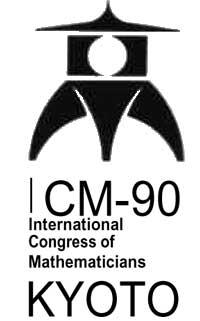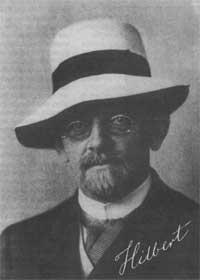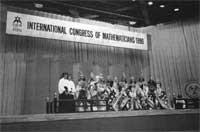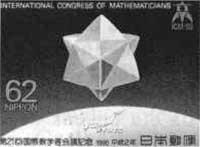International Congresses of Mathematicians
Almost four thousand mathematicians met last August in the Japanese city of Kyoto to participate in the International Congress of Mathematicians held for ten days. XIX. Born in the last decade of the 20th century, like the new Olympic Games, they will soon turn their first centenary. Like these, they are held four to four years (but not the same year) and have only suffered interruptions during the war.
Before the First War

About a hundred years ago, like the famous fifth centenary that comes, the celebrations of the fourth were prepared in some places. Among other things, in 1893 the Universal Exposition was held in Chicago and as a complementary action a Congress of Mathematicians was organized. In addition to three or four invited Europeans, only some unknown Americans participated. The introductory talk was given by the German Felix Klein under the title “The current state of mathematics”.
At that meeting in Chicago he sowed the seed or, four years later, in 1897 the first “International Congress of Mathematicians” was held in Zürich. It lasted three days, with more than two hundred participants and four main speakers: Poincaré (although it was not due to illness, another read his speech), Hurwitz, Peano and Klein. The Swiss Ferdinand Rudio, who served as secretary of Congress, spoke about his functions and organization and the congressmen showed their intention to keep it in the future, within three to five years.
Only three years passed from the first to the second, as it was held in Paris in 1900. That same year at the end of the century the mathematicians met together with a Universal Exposition. Seven days this time, in a congress longer than the previous. Henri Poincaré (certainly one of the most prestigious mathematicians of the time) was president and Moritz Cantor (not George, creator of set theory), along with Gösta Mittag-Leffler and Vito Volterra, one of the four main speakers. But the conference that recalled the future was not one of them, but the one offered by David Hilbert.
Under the common title “Mathematical Problems”, Hilbert referred to the problems that, in his opinion, would mark the future, since there was no solution to the problems presented to him with the mathematical instruments of then. They were twenty-three and twentieth. Although the resolution of some has been achieved in the 20th century, others are still waiting. But, undoubtedly, the resolute and determined have brought with them new theories and methods and an important development. Hilbert's conference appears as the fifth general conference, when the minutes of the congress were published.
Subsequently, the term between congresses was established in four years, period that was initially maintained: The next three congresses were held in Heidelberg in 1904, Rome in 1908 and Cambridge in 1912. Participation was also increasing. About six hundred people came to Cambridge. Stockholm was appointed to host the sixth congress for the year 1916, but at the outbreak of the first World War two years earlier it was pending.
Interwar period

The next congress had to be held in 1920 to regain the frequency of four years after the war. It was organized in the French city of Strasburg. But the congress was not fully open, as the participation of mathematicians from the lost states in the war was not allowed. It should be noted that the best mathematics centres of the time were in France and Germany and that all those in the latter were left out. Also noteworthy is the symbolism of the congress headquarters: After moving from one hand to another in the clashes between Germany and France, the 1919 Versailles treaty left it for the French. The reduction of participation was not to the liking of all and other mathematicians decided not to attend. These, moreover, rejected this congress for the continuity of the others and then the congresses carry no order number.
The year 1924 was dedicated to New York City, but the organization ceded and finally held in Toronto. He had no special mathematical specificity, but could not fail to mention J.C. He was president of Fields, as later his influence will emerge.
Four years later, the following occurred in the Italian city of Bologna. Ten years have passed since the end of the war and objections from previous congresses were removed, inviting the Germans. The separation then occurred between the supporters of one (led by Hilbert) and the other (called Bieberbach). In the end Hilbert left with sixty more. Years later, when the situation deteriorated in Germany, Bieberbach was in favour of the Nazis and Hilbert and those at his school suffered anguish.
The 1932, as well as the initial one, was held in Zürich. The Zürichtarras organizers had the time of the economic crisis, but in spite of that, about seven hundred participants gathered. For the first time a woman appeared among the main speakers: Emmy Noether, German. In the congress it was decided to reward two mathematicians for the work done in each congress. This was J.C. Fields' last wish, leaving for it the economic benefits of the Toronto congress and some of its assets. Fields died in 1931 and the awards are known by name: “Fields Medals.”
The 1936 congress was held in Oslo. Participation declined in the world due to the serious political situation (especially in Germany and Italy). Following the decision made in Zürich, the first medals were offered Fields, Lars Ahlfors and J. Douglas Prize. Born in Ahlfors Helsinki, he worked at Harvard University and American Douglas at the Massachusetts Institute of Technology. Both are famous centers located in the neighboring city of Cambridge in Boston.
Four years later the world was again at war and the succession of congresses suffered a second suspension, without organizing what had to be done in the United States in 1940.
After the Second War

World War II was a long break: fourteen years passed from the Oslo Congress to the next. He was in Cambridge in 1950, but not in England as in 1912, but in the United States that we mentioned a little earlier. The political situation of the world again affected the organization of the congress: in times of the Cold War they moved to the United States from all places they could not be, and the objection was not only for those of the Eastern European State, but also denied or granted to others under conditions. For example, Frenchman Laurent Schwartz, who won the “Fields Medal,” got a week-long visa but was banned from travelling in the United States. However, there were 1700 participants.
Another important consequence of the war was the emigration of many mathematicians of different origin to the United States. This is very evident if we look at the list of leading speakers of the congress: more than half worked at the universities of the United States, but, except for some, not all were born Americans. The damage was noticed in Europe.
In 1954 in Amsterdam there were four Soviets and one Pole among the main speakers. It is worth noting Von Neumann’s lecture entitled “Unresolved Problems” (in the spirit of what Hilbert did at the beginning of the century, but apparently less general). When he died shortly thereafter, he did not prepare a writing to publish it and the text of the conference has not remained.
The congresses held in 1958 in Edinburgh and 1962 in Stokholm deserve no special mention. Yes 1966, as it was done in Moscow. Those who were left without going on this occasion were “others,” say. As in the Soviet Union there are many mathematicians, the participation was very high: about four thousand, coming from 49 states.
Because there was more money for the “Fields” awards, the congressional prizes went up to four. Among the winners in Moscow was the American Stephen Smalle, known member of the anti-Vietnam war acts, who demonstrated an old conversion of Poincaré in dimensions greater than five (in three dimensions it is still to be demonstrated). On the stairs of the University of Moscow he offered a press conference criticizing the United States for the Vietnam War and denouncing the lack of freedom of expression of the Soviet Union. This caused him trouble when he returned to America.
Nice, Vancouver (Canada) and Helsinki were the headquarters of the next congresses and what was to be held in 1982 corresponded to Vart<unk>. But in Poland there were political riots and that year they were subject to martial law. The International Union of Mathematicians decided to postpone the congress one year and was held in 1983, although in all symbols the number 1982 remained.

Throughout the previous year a debate arose among mathematicians (especially in Americans): some considered that if they took part they helped the Polish government; others, on the contrary, could be more direct with assistance. Many of the supporters of the first position were left uninvolved and the United States, for example, only a hundred. Congress conferences were often devoted to one of the Polish mathematicians present in prison, although most were already on the street.
The last congress to date was held in California Berkeley in 1986.
ICM- 90 Kyoto
Kyoto, the capital of Japan, hosted the last congress of mathematicians from August 21-29. More than half of the four thousand participants were Japanese, followed by those of the United States (more than three hundred), while the Soviets and French went by a hundred. In total it was a representation of 83 states. It is a fact that highlights the universality of congresses. To take advantage of the presence of so many foreign mathematicians traveling to the international congress, in previous and subsequent weeks twenty congresses were organized in different places in Japan, in which specialized topics were analyzed.
The internal organization of the Congress has remained the same in the last twenty years. On the one hand, we have the general talks. They are one hour long, in the morning, and are addressed to all participants, that is, there is only a general conference. Last year there were fifteen in total and the first was issued by Karen Uhlenbeck, thus becoming the second guest woman as keynote speaker (as mentioned earlier was Emmy Noether at the 1932 congress).
In the afternoon, three-quarter hour conferences, which also involve guests, divided into eighteen specialties and held in six simultaneous sessions. About one hundred and fifty of them were present in Kyoto. Finally, short communications of 10 minutes, simultaneous to the previous ones. These were (along with other complementary acts) those that appeared in the official program, but in it informal seminars and round tables were organized for dissemination through the daily bulletin.

All general talks were given in English. It is interesting to observe the evolution of languages used in the history of congresses. The conferences have been given in five languages: French, English, Russian, German and Italian. The last two disappeared first and then Russian and French. Now not only the main papers, but also most others were given in English (some were in French, if I'm not mistaken).
There has been nothing relevant mathematical in the congress. When specialization is increasing, it is very difficult to follow the thread in discourses outside the subject. But the main conferences and the works awarded with the “Fields Medal” show us that the most prosperous mathematics is carried out by joining the contributions of the different fields. However, it does not seem that the results obtained in the last four years have been satisfactory.
The International Mathematical Union has re-elected Zürich as the venue for the next congress for the third time (so far it has not been held elsewhere). This next congress will be held in 1994 and should be considered in some way for the centenary of the first, since it was in 1897 and does not correspond to its centenary.
And as the end of the century approaches, someone should do it (as Hilbert did in Paris in 1900) for the next century: Why ways will start the new problems of mathematics (or old), etc. But these one hundred years have not passed uselessly and the volume of Mathematics has expanded to such an extent that it is not possible for a single person to approach that work. If you do, it will be a teamwork. It is also a sample of the trend of Mathematics and Science, as there are fewer and fewer individual jobs.
FIELDS Awards Alfred Nobel did not give rise to Mathematics among the prestigious prizes bearing his name. That's why J. C. Fields, president of the congress held in Toronto in 1924, left in his will money to create a prize among mathematicians. The prize was to be awarded at international congresses (not every year as the Nobel Prize) and in each of them two mathematicians would be winners, although subsequently the number of prizes increased to four. The International Union of Mathematicians designates a special commission to decide who the chosen ones are, this year being four of the eight winners. According to Fields’ proposal, “the recognition of the work done and the impulse to what was to be done,” it was concluded that it was an award aimed at young people. Therefore, although it is not a written norm, it is only given to mathematicians under forty. The winners in 1990 were: 1) V.G. Drinfeld, born in Kharkov (Ukraine) in 1954 and working at the Low Temperature Institute of the Ukrainian Academy of Sciences; 2) Vaughan F. R. Jones, born in Gisborne (New Zealand) in 1952 and now working at the University of California at Berkeley (he did his thesis in Switzerland); 3) Shigefumi Mori, born in Printo in 1951 and professor at the University of Berkeley, 4) Edward Institute for Witt, who was born in 1951 and is a member of the Etchat Adstance. Witt is a theoretical physicist, one of the leading representatives of supercommand theory, now so fashionable. He is very skilled in the mathematical expression of the ideas of Physics and has obtained new results in Mathematics from that idea. It is worth mentioning, on the other hand, the relationship between works by Drinfeld, Jones and Witten apparently found in different sections of Mathematics, as was shown when the mention was made of his work congress was made. With this year there are already twenty mathematicians who have received the Fields medal. As for their country of origin, thirteen are from different states, but considering the place where they had their job when they got the prize, only seven remain: Italy, Sweden and Japan, three in the Soviet Union, four in Britain, six in France and eighteen in the United States (born in the same Soviet Union). According to age, only four were under 30 years old, aged between seventeen 35 and 39. There are no women winners. |





